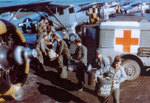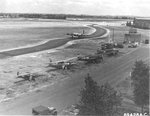C-64 Norseman
| Country | Canada |
| Manufacturer | Noorduyn Aviation Ltd, Montreal, Canada |
| Primary Role | Transport |
| Maiden Flight | 14 November 1935 |
Contributor: Alan Chanter
ww2dbaseThe Noorduyn Norseman utility transport aircraft designed by Dutch born Aircraft builder Robert B. Noorduyn (1893-1959) was one of the oldest and best known bush aircraft. The Norseman I prototype, built in the former Curtiss-Reid factory near Montreal, Quebec, Canada, made its maiden flight in November 1935, powered by a Canadian built 420-horsepower Wright R-975-E3 nine-cylinder air-cooled radial. A classic high-wing tube and fabric monoplane with a fixed tail-wheel undercarriage which included large heavily faired main legs. The wheels could be replaced with skis or floats to give the Norseman aircraft a go-anywhere capability in the severe climatic conditions of the Canadian winter. An enclosed heated cockpit with side-by-side seating for two was located forward of the wing centre section with, behind and below it, a roomy cabin for eight passengers seated on easily removable bench seats, so that little time was needed to change the interior to transport freight. An additional 20 cubic feet of baggage/cargo space was provided beneath the cabin floor.
ww2dbaseA small batch of seventeen civil aircraft were built before the war. Production began with the Norseman II (three built) which had only minor changes from the prototype. The Wright engine proved to be underpowered and the following two aircraft (Norseman III) were fitted with 450 horsepower Pratt & Whitney Wasp SC radial engines. These were followed by Norseman IV aircraft with Pratt & Whitney S3H1 engines.
ww2dbaseHowever the main production run was for the USAAF who, after testing a single aircraft placed an order for another six Norseman IV aircraft (YC-64) for communication tasks during World War II. These had ten seats and 600 horsepower R-1340-S3H1 engines. This initial batch was followed by a subsequent order for more machines powered by 550 horsepower Pratt & Whitney Wasp R-1340-AN1 engines (C-64A and later UC-64A Norseman VI). In total some 749 Norseman aircraft would be delivered to the US military. Three of this total were transferred to the US Navy, which designated them JA-1, and six with twin floats were used by the US Army Corps of Engineers (UC-64B). With its ability to take-off and land in difficult terrain the Norseman aircraft soon became known as "The one-ton flying truck" and "The workhorse of the skies". Norseman aircraft were also ordered by the RCAF with deliveries, initially consisting of four Norseman IV aircraft, commencing in 1939, which would be operated as wireless trainers under the designation Norseman Mk. IVW. Additional purchases were made following Canada's entry into World War II. The designation Norseman V aircraft was not used during the war years; the patriotic Bob Noorduyn reserving this for his first civil aircraft at the end of hostilities- the V signifying Victory.
ww2dbaseOn 15 December 1944, a USAAF UC-64A aircraft flown by Flight Officer John Morgan took off from Twinwood Farm, near Bedford, England, United Kingdom to take the popular band leader, Glenn Miller (q.v.) to join his musicians in Paris, France. Somewhere over the English Channel the aircraft disappeared with the loss of all on board. In another 1944 accident a Norseman aircraft crashed into King Alfred's tower, a 50-meter tall folly on Kingsettle Hill, Somerset, England, tragically killing all five air crew.
ww2dbaseIn early 1946, Canadian Car and Foundry Company (CCF) acquired the manufacturing and sales rights for the Norseman, building a further 53 as civilian Norseman V aircraft. They also developed their own Norseman VII prototype which incorporated an all-metal wing and tailplane together with a lengthened cabin. This aircraft flew in 1951 but no production examples were ever built. In May 1953 CCF sold all rights in the Norseman to a specially formed company, Noorduyn Norseman Aircraft Limited, which continued to provide product support.
ww2dbaseOther military operators of the Norseman during or post World War II included the air forces of Australia, Brazil, Honduras, Indonesia/Netherlands East Indies, Norway and Sweden. By the time Norseman production ended in 1959 some 904 aircraft, including prototypes, had been built. Norseman civilian models and military surplus aircraft would become extremely popular after the war with bush operators and various small airlines. Many still remain active today with private owners known in Canada, Sweden and the United States.
ww2dbaseSources:
Rod Simpson: Airlife's World Aircraft (Airlife Publishing Ltd (2001)
World Aircraft Information Files, Files 902/09 & 902/10 (Aerospace Publishing Periodical)
Wikipedia - Noorduyn Norseman
Last Major Revision: Jun 2020
C-64 Norseman Timeline
| 14 Nov 1935 | The Noorduyn Norseman utility transport aircraft took its first flight. |
| 15 Dec 1944 | Noted American dance band leader Glenn Miller departed England, United Kingdom aboard a Noorduyn C-64A Norseman aircraft piloted by Flight Officer John R. S. "Nipper" Morgan for Villacoublay, France. The aircraft disappeared somewhere over the English Channel. |
SPECIFICATIONS
Norseman V
| Machinery | One Pratt & Whitney Wasp R-1340-AN1 piston engine rated at 550hp |
| Armament | Unarmed; 1,288kg useful Load, 8-10 passengers |
| Crew | 1 |
| Span | 15.75 m |
| Length | 9.85 m |
| Height | 3.07 m |
| Wing Area | 30.20 m² |
| Weight, Empty | 1,923 kg |
| Weight, Loaded | 3,419 kg |
| Speed, Maximum | 249 km/h |
| Speed, Cruising | 227 km/h |
| Service Ceiling | 5,200 m |
| Range, Normal | 742 km |
Photographs
 |  |  |
Please consider supporting us on Patreon. Even $1 per month will go a long way! Thank you. Please help us spread the word: Stay updated with WW2DB: |
- » US Government Plans to Purge WW2 Information (17 Mar 2025)
- » WW2DB's 20th Anniversary (29 Dec 2024)
- » Wreck of USS Edsall Found (14 Nov 2024)
- » See all news
- » 1,166 biographies
- » 337 events
- » 44,601 timeline entries
- » 1,243 ships
- » 350 aircraft models
- » 207 vehicle models
- » 376 weapon models
- » 123 historical documents
- » 261 facilities
- » 470 book reviews
- » 28,551 photos
- » 375 maps
Winston Churchill
Please consider supporting us on Patreon. Even $1 a month will go a long way. Thank you!
Or, please support us by purchasing some WW2DB merchandise at TeeSpring, Thank you!